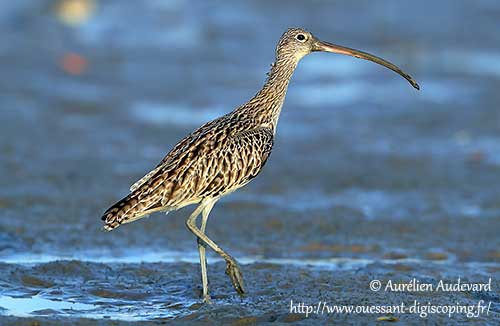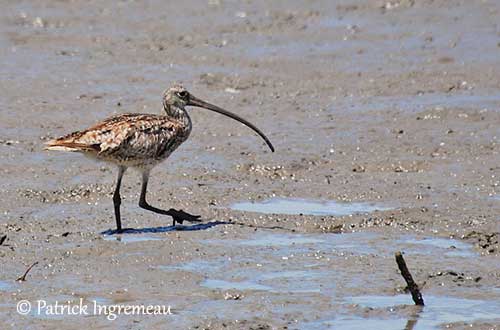
Fr: Courlis de Sibérie
Ang: Far Eastern Curlew
All: Isabellbrachvogel
Esp: Zarapito Siberiano
Ita: Chiurlo orientale
Nd: Siberische Wulp
Sd: orientspov
Photographers:
Aurélien Audevard
OUESSANT DIGISCOPING
Patrick Ingremeau
TAMANDUA
Ian McHenry
My New Zealand Birds
Otto Plantema
Trips around the world
Text by Nicole Bouglouan
Sources:
HANDBOOK OF THE BIRDS OF THE WORLD Vol 3 by Josep del Hoyo-Andrew Elliott-Jordi Sargatal - Lynx Edicions - ISBN: 8487334202
GUIDE DES LIMICOLES de D. Taylor - Delachaux et Niestlé - ISBN : 2603014080
SHOREBIRDS by Peter Hayman, John Marchant and Tony Prater – Christopher Helm – 1986 – ISBN: 0747014035
A Field Guide to the Birds of South-East Asia by Craig Robson. New Holland Publishers. ISBN: 9781780090498
Birds in backyards (Birds Australia and Australian Museum)
Saving a migratory icon: Recovering the Far Eastern Curlew
The Guardian - To the moon and back with the eastern curlew
Office of Environment & Heritage
New Zealand birds and birding (Narena Olliver)
What Bird-The ultimate Bird Guide (Mitchell Waite)
Wikipedia, the free encyclopaedia
Far Eastern Curlew
Numenius madagascariensis
Charadriiformes Order – Scolopacidae Family
INTRODUCTION:
The Far Eastern Curlew is the largest curlew and the largest wader in the world. The species is known for its very long migration, up to 30,000 kilometres per year, between the breeding grounds in E Siberia and the wintering areas in Australia with some individuals reaching New Zealand.
This large curlew has a very long, heavy, decurved bill, well-adapted to probing behaviour in the mud, while searching for invertebrates, especially crabs and molluscs.
Like numerous waders, it nests on the ground in a shallow depression. It frequents intertidal mudflats in estuaries, bays and lagoons, but it breeds mainly on swampy moors and boggy marshes.
The Far Eastern Curlew is threatened by habitat loss at stopover sites, especially degradation of wetlands, but disturbance at nesting and feeding sites and persecution involve the decline of the population.
The Far Eastern Curlew is currently listed as Endangered.

The head is buffish-brown with dark streaks, but the crown is slightly darker. The supercilium is whitish and we can see a narrow, white eyering. The lores are blackish. Chin and throat are white. The neck is buffish-brown with dark streaks.
The long, decurved bill is dark brown with pinkish base, especially on lower mandible. The eyes are dark brown. Legs and feet are pale blue-grey. In flight, the toes protrude beyond the tip of the tail.
Male and female have similar plumage, but the female is heavier, with longer bill.
The juvenile is paler, with more extensive white edges to upperpart feathers. On the underparts, the streaks are narrower. The bill is shorter than that of adults.
RANGE:
The Far Eastern Curlew breeds in E Siberia, E Mongolia and NE China.
It winters in Japan, E China and Taiwan, S to Indonesia and New-Guinea. Most of them migrate to Australia, and small numbers reach New Zealand.
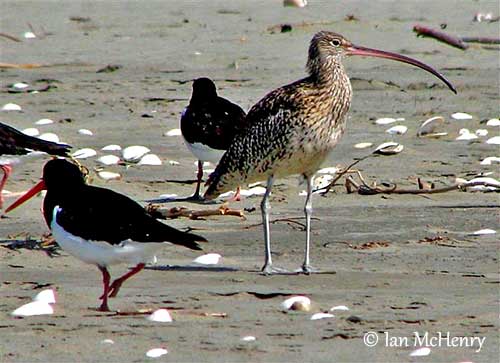
Observed in
New Zealand
HABITAT:
The Far Eastern Curlew breeds in marshy, boggy habitats, wet meadows and open mossy bogs. It also frequents the swampy shores of small lakes. However, it nests mainly in dry sites over wet areas.
During winter, this species is mainly coastal and usually frequents estuaries, swampy mangroves, saltmarshes and intertidal mudflats, and sometimes beaches. It is rarely seen inland, even in large wetlands.
CALLS AND SONGS: SOUNDS BY XENO-CANTO
The Far Eastern Curlew’s usual contact call is a “coor-ee” less fluty and flatter than that of the Eurasian Curlew.
When the bird is disturbed or alarmed, it gives a bubbling trill “ker-ee-ker-ee…” or “carr-eeir carr-eeir…”
BEHAVIOUR IN THE WILD:
The Far Eastern Curlew feeds mostly by deep probing, thanks to its very long bill. It feeds primarily on small crabs and molluscs, but it also takes insects including larvae of beetles and flies, and amphipods. Berries are also part of its diet during migration.
It probes into the mud or pecks from the surface. Prey are located by sight or touch. The larger prey are manipulated in order to swallow them piece by piece. Some prey are sometimes washed.
The female has longer bill, and usually feeds solitary and even defends her feeding territory. The male feeds mostly in loose flocks. Both are diurnal and nocturnal.
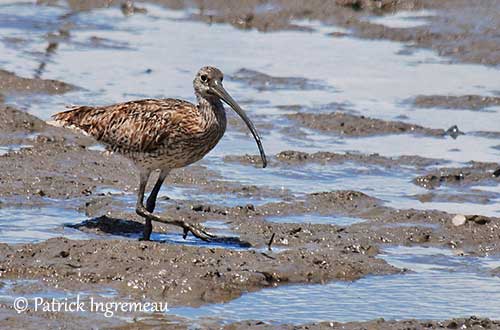
The Far Eastern Curlew is territorial during the breeding season. The male performs a gliding display flight on slightly-downcurved wings while producing its bubbling song. This flight is performed about 10-15 metres above the ground.
This species nests on the ground in damp bogs and peaty marshes, sometimes in small groups of 2-6 pairs.
The Far Eastern Curlew is a long-distance migrant through Australasia and eastern parts of SE Asia. There are some records of vagrancy in W Alaska and the Aleutian Islands, and more recently in Afghanistan and Thailand.
It uses the “East Asian – Australasian Flyway” (EAAF). This route extends from the northern breeding areas in parts of Russia, China, Mongolia and Alaska, to the southern non-breeding grounds in parts of SE Asia, Australia and New Zealand.
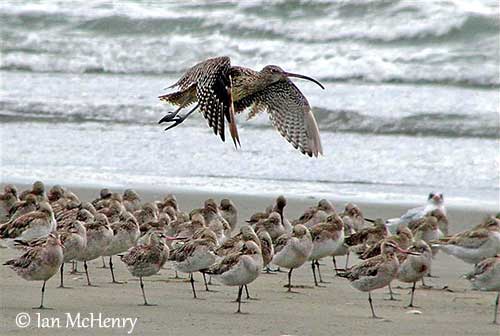
Observed in
New Zealand
If the weather conditions are too bad, the bird waits. But in good conditions, it will begin an epic journey and will fly nonstop to the Yellow Sea, with a stopover on the mudflats of NE China. Then, it will continue flying both days and nights, crossing the oceans to reach the coasts of Australia.
The Far Eastern Curlew is known for flying 30,000 kilometres a year, only by flapping its wings because it does not soar or glide. It usually follows the coastlines.
The bird survives on stored body fat. When it is ready to fly, it is described as a “balloon” because the bird feeds frantically and gains 80 % of its weight in fat.
The flight is strong and direct, with slow, deliberate wingbeats.
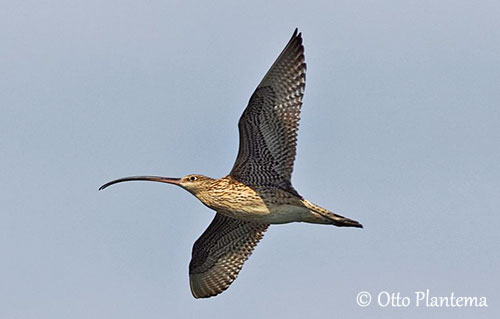
REPRODUCTION OF THIS SPECIES:
The breeding season occurs from early May to late June. It breeds in swampy and marshy wetlands and lakeshores. It may use the same areas for several years, but it may change too.
The nest is on the ground, usually on small mound in swampy ground. It is lined with dry grass and twigs, and is often close to areas where the birds can find berries.
The female lays 2-4, usually 4 olive-green eggs with dark speckles. The incubation lasts 27-29 days, shared by both parents.
The chicks leave the nest very soon after hatching. They are able to feed themselves, taking both insects and small invertebrates.
PROTECTION / THREATS / STATUS:
The Far Eastern Curlew is primarily threatened by habitat loss, especially on Yellow Sea, with loss of stopover sites due to growing human population. Wetland degradation, disturbance at nesting and feeding sites, persecution, pollution involving the decrease of food resources and predation, are the main causes of population decline.
The global population was estimated at 38,000 individuals in 2006, with a more recent update at 32,000 individuals in 2015. It is assumed that these declines will continue, due to the previous threats.
The Far Eastern Curlew is currently listed as Endangered.
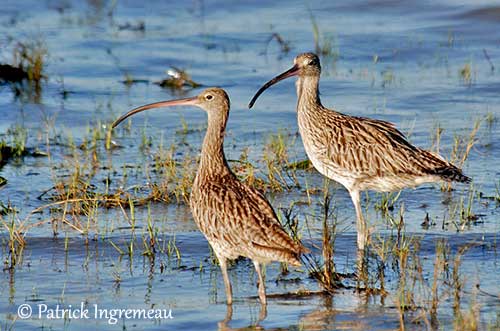
DESCRIPTION OF THE BIRD:
Biometrics:
Length: 60-66 cm
Wingspan: 97-110 cm
Weight: 390-1350 g
Bill length: M: 155 mm – F: 184 mm
The Far Eastern Curlew has brown upperparts with pale olive-brown edges and dark centres to feathers. The rump is more uniformly brown. The tail is greyish-brown with narrow dark bars. The flight-feathers are brown with secondaries and inner primaries notched white.
The underparts are brownish-buff, paler towards the vent. Breast and flanks are streaked, with thicker streaks on flanks. The underwing is whitish with fine dark barring.
